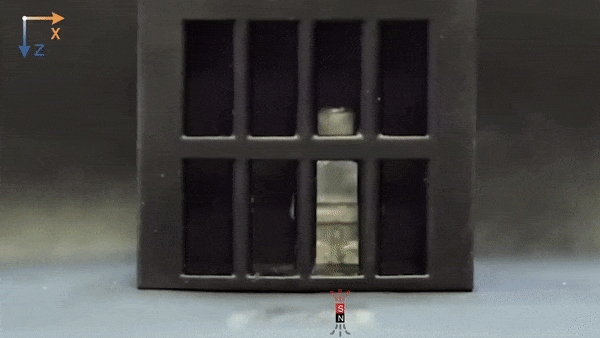
One of the many iconic moments in Terminator 2: Judgment Day was seeing the T-1000 briefly morph into a liquid to pass through the metal bars separating him from his target: a teenage John Connor. A team of engineers mimicked that famous scene with a soft robot in the shape of a Lego minifig. The robot "melts" into liquid form in response to a magnetic field, oozing between the bars of its cage before re-solidifying on the other side. The team described its work in a recent paper published in the journal Matter.
As we've previously reported, we traditionally think of robots as being manufactured out of hard, rigid materials, but the subfield of soft robotics takes a different approach. It seeks to build robotic devices out of more flexible materials that mimic the properties of those found in living animals. There are huge advantages to be gained by making the entire body of a robot out of soft materials, such as being flexible enough to squeeze through tight spaces to hunt for survivors after a disaster. Soft robots also hold strong potential as prosthetics or biomedical devices. Even rigid robots rely on some soft components, such as foot pads that serve as shock absorbers or flexible springs to store and release energy.
For instance, Harvard researchers built an octopus-inspired soft robot in 2016 that was constructed entirely out of flexible materials. Soft robots are more difficult to control precisely because they are so flexible. So, for the "octobot," they replaced the rigid electronic circuits with micro-fluidic circuits. Such circuits regulate the flow of water (hydraulics) or air (pneumatics), rather than electricity, through the circuit's microchannels, enabling the robot to bend and move. In 2021, engineers at the University of Maryland built a three-fingered soft robotic hand that is sufficiently agile to be able to manipulate the buttons and directional pad on a Nintendo controller—even managing to beat the first level of Super Mario Bros. as proof of concept.
This latest robot belongs to a class known as magnetically actuated miniature machines, typically made of soft polymers (like elastomers or hydrogels) embedded with ferromagnetic particles that have programmed magnetization profiles. These kinds of robots can swim, climb, roll, walk, and jump, as well as change their shape simply by altering the corresponding magnetic field. That makes them ideal for several biomedical applications, such as targeted drug delivery and therapy for healing ulcers. But according to the authors of the new paper in Matter, such elastomer-based composites are difficult to steer through very narrow and confined spaces where the openings are smaller than the dimensions of the material because they are essentially solids and thus have limited deformability.
Eager to find a solution, they looked to the humble sea cucumber for inspiration. Sea cucumbers are fascinating creatures with soft cylindrical bodies and mouths surrounded by retractable tentacles. Some species can even vomit toxins as a means of self-defense. But it's the sea cucumber's remarkable ability to loosen and tighten at will the collagen that forms the walls of their body that intrigued these engineers. This lets the sea cucumber essentially "liquefy" its body to squeeze through tiny cracks and crevices, hooking all those collagen fibres back together afterward to once again form a solid body.
The new mini-robot is made of magneto-active phase transitional matter (MPTM), capable of switching back and forth between solid and liquid states. When the MPTM is heated with an alternating magnetic field, it melts into a liquid, while ambient cooling lets it resolidify when the magnetic field is removed. MPTMs are composed of ferromagnetic neodymium-iron-boron microparticles embedded in pure gallium. The resulting material has a melting point of 30.6° C (about 87° F), so it remains solid at room temperature. In its solid form, the MPTM has excellent mechanical strength, good for bearing high loads, and versatile mobility. In its liquid phase, the microparticles can rotate and reorient their magnetic polarity to lengthen, divide, and merge as needed.
Demonstration of MPTM smart-soldering robot for circuit repair. Credit: Q. Wang et al., 2023
“The magnetic particles here have two roles,” said co-author Carmel Majidi, a mechanical engineer at Carnegie Mellon University. “One is that they make the material responsive to an alternating magnetic field, so you can, through induction, heat up the material and cause the phase change. But the magnetic particles also give the robots mobility and the ability to move in response to the magnetic field.”



3175x175(CURRENT).thumb.jpg.b05acc060982b36f5891ba728e6d953c.jpg)

Recommended Comments
There are no comments to display.
Join the conversation
You can post now and register later. If you have an account, sign in now to post with your account.
Note: Your post will require moderator approval before it will be visible.